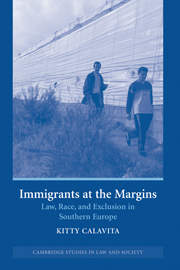Book contents
- Frontmatter
- Contents
- List of tables
- Preface
- Acknowledgments
- Maps
- 1 Introduction
- 2 Legal framework and the wayward “legs of law”
- 3 “Useful invaders”: the economics of alterité
- 4 Integrating the “Other”
- 5 The Everyday dynamics of exclusion: work, health, and housing
- 6 Fuel on the fire: politics, crime, and racialization
- 7 Conclusion: immigrants and other strangers in the global marketplace
- Notes
- Bibliography
- Index
6 - Fuel on the fire: politics, crime, and racialization
Published online by Cambridge University Press: 04 July 2009
- Frontmatter
- Contents
- List of tables
- Preface
- Acknowledgments
- Maps
- 1 Introduction
- 2 Legal framework and the wayward “legs of law”
- 3 “Useful invaders”: the economics of alterité
- 4 Integrating the “Other”
- 5 The Everyday dynamics of exclusion: work, health, and housing
- 6 Fuel on the fire: politics, crime, and racialization
- 7 Conclusion: immigrants and other strangers in the global marketplace
- Notes
- Bibliography
- Index
Summary
Tahar Ben Jelloun begins the memoir of his immigration to France: “Often with immigration it's the aesthetics that cause problems. Immigrants are not photogenic, except in cases of tragedy, when their image is all over the newspaper. Their looks are not reassuring.” Integration programs partly constitute an effort to stave off the backlash against those who are not “photogenic,” but who are nonetheless useful. The “aesthetic” problem derives from that utility, since by definition cheap and flexible labor bears the ugly stigma of poverty, a stigma that the social and spatial segregation described in the previous chapters draws attention to and enhances.
In this chapter, I follow through the logic of this disfiguring stigmatization and its unseemly consequences. For, immigrants are not just excluded, they are criminalized; they are not just different, they are dangerous. Above all, they are racialized. And, that racialization is part and parcel of the economics of alterité, as those who at other times and in other places were themselves declared racially inferior now construct others in that role. The dynamic is at once structurally driven and fueled by politicians and a media that are drawn to, and make careers from, the frightening and the macabre. Tahar Ben Jelloun may be right, immigrants are only photogenic in cases of tragedy. But, given the saturation of the Spanish and Italian media with images of boat people, human smugglers, and African prostitutes, the tragedy is in part constituted by the images themselves.
- Type
- Chapter
- Information
- Immigrants at the MarginsLaw, Race, and Exclusion in Southern Europe, pp. 125 - 156Publisher: Cambridge University PressPrint publication year: 2005

